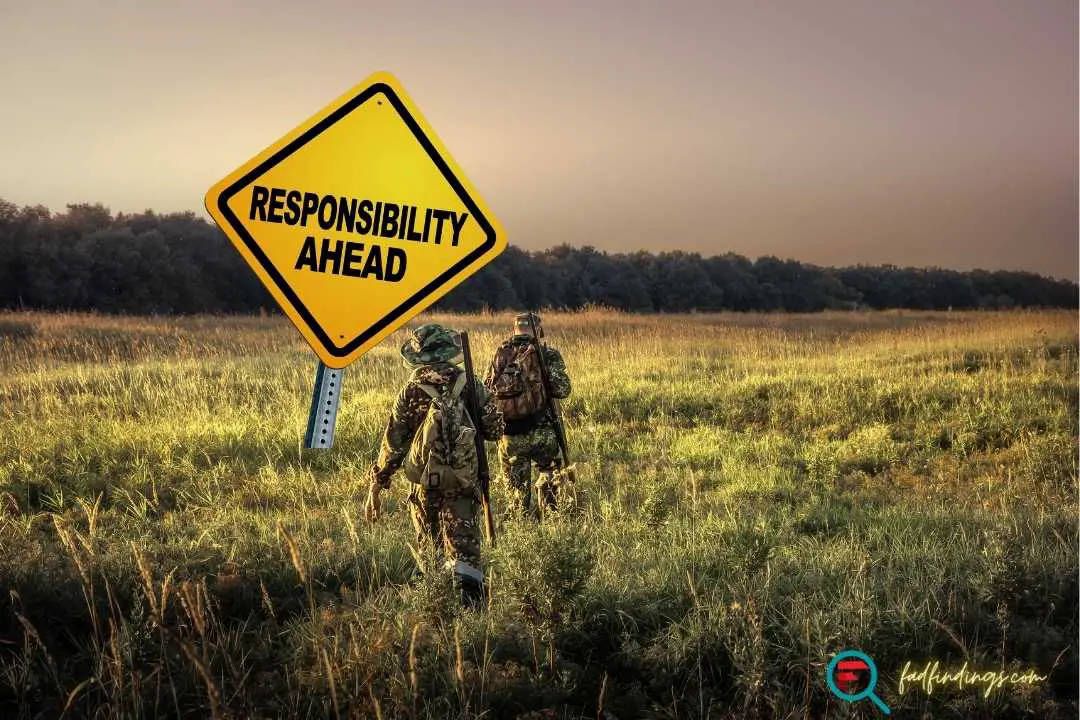The Art of Turkey Calling: How to Impress Both Birds and Judges
Are you struggling to make the right Turkey Calls? Don't worry, we've got you covered. Check out our article on Turkey Calling and become a pro in no time. Read on to learn how to communicate with your prey and increase your chances of success.
Are you a turkey hunter looking to improve your skills and up your game?
Look no further than this comprehensive guide to the art of turkey calling!
Calling wild turkeys is a critical aspect of the sport, requiring practice and skill to do it effectively. In this article, we'll cover everything you need to know, from the basics of different types of turkey calls to advanced strategies for calling in turkeys.
So, whether you're a seasoned hunter or just starting, sit back, grab a cup of coffee, learn the art of turkey calling, and increase your chances of a successful hunt!
The Basics
Turkey calling is an essential part of turkey hunting, and it separates successful hunters from those who come home empty-handed. The ability to mimic the sounds of a turkey can lure a bird out of hiding and bring it within range for a successful shot.
This guide will cover everything you need to know about turkey calling, from the basics of turkey vocalizations to the types of calls available and how to use them effectively.
Understanding Turkey Vocalizations
Before you start calling turkeys, you must understand the turkey vocabulary to know what you are replicating. Here are the main wild turkey sounds you need to know before you begin hunting for spring turkeys:
Clucks
A plain cluck sound is the most common among turkey calls. It consists of a series of staccato noises made by male and female turkeys, vital to sustaining contact with their flock.
These calls are meant to notify their presence and often signify contentment, whether during the day while searching for food or in the evening when roosting.
Purrs
Turkeys often emit a soft and rumbling purr when content or at ease. This gentle sound is usually heard during roosting hours at night or while they tend to their feathers. Additionally, it can be used as a concession when aggressive encounters arise between them.
Yelps
Yelps are the most common turkey vocalization used by both hens and toms. They are used to locate other birds and can be made in various tones and volumes. A low muffled series of yelps (often called tree yelps or tree call) is their basic mode of communication and can signify anything like the start of their day or indicate their location.
Yelps can sound high-pitched and excited, used as a general alarm call or to indicate excitement about food or other resources. Depending on the turkey's mood, dominating hens often use excited yelps to indicate that they are ready to mate. Yelps are often made in a series of quick, rhythmic bursts.
Gobbles
The most well-known vocalization that male turkeys make is the gobble. This loud, deep sound is usually made by male turkeys during the breeding season to attract females.
The gobble is a long, drawn-out sound that can be heard up to a mile away in the right conditions. It is often accompanied by strutting and puffing out of feathers to attract the attention of nearby hens.
Kee-Kee
The kee-kee call, a two-note pitch emitted by juvenile turkeys, is a vital communication tool to maintain contact with their mother and flockmates – especially when they've lost sight of one another.
In the fall hunting season, it's common to hear these high-pitched sounds from young turkeys learning how to roost independently.
Putts
Putts are abrupt, shrill sounds that turkeys produce when distressed or concerned. This sound is frequently used to warn other turkeys of impending danger.
If you hear putts while hunting, it's wise to pause and cautiously survey your environment.
Cutting
From a distance, cutting sounds like a fast-paced thrill of clucks and yelps made by female turkeys ready to mate. It's the way hens signal their readiness to any tom within earshot. Cutting is an alluring call that males cannot ignore!
Assembly Call
The assembly call is a loud, repetitive sound made by turkeys trying to regroup after being scattered by a threat. It is a series of loud yelps meant to bring the flock back together.
Types of Turkey Calls
Many types of turkey calls are available, and each has its unique sound and purpose. Here are the seven main types of turkey calls:
Box Calls

Box calls are one of the easiest calls to use and are often recommended for beginners. They consist of a wooden box with a lid that is moved back and forth to create a sound. They have a durable build quality and sound great in all weather conditions.
Pot Calls
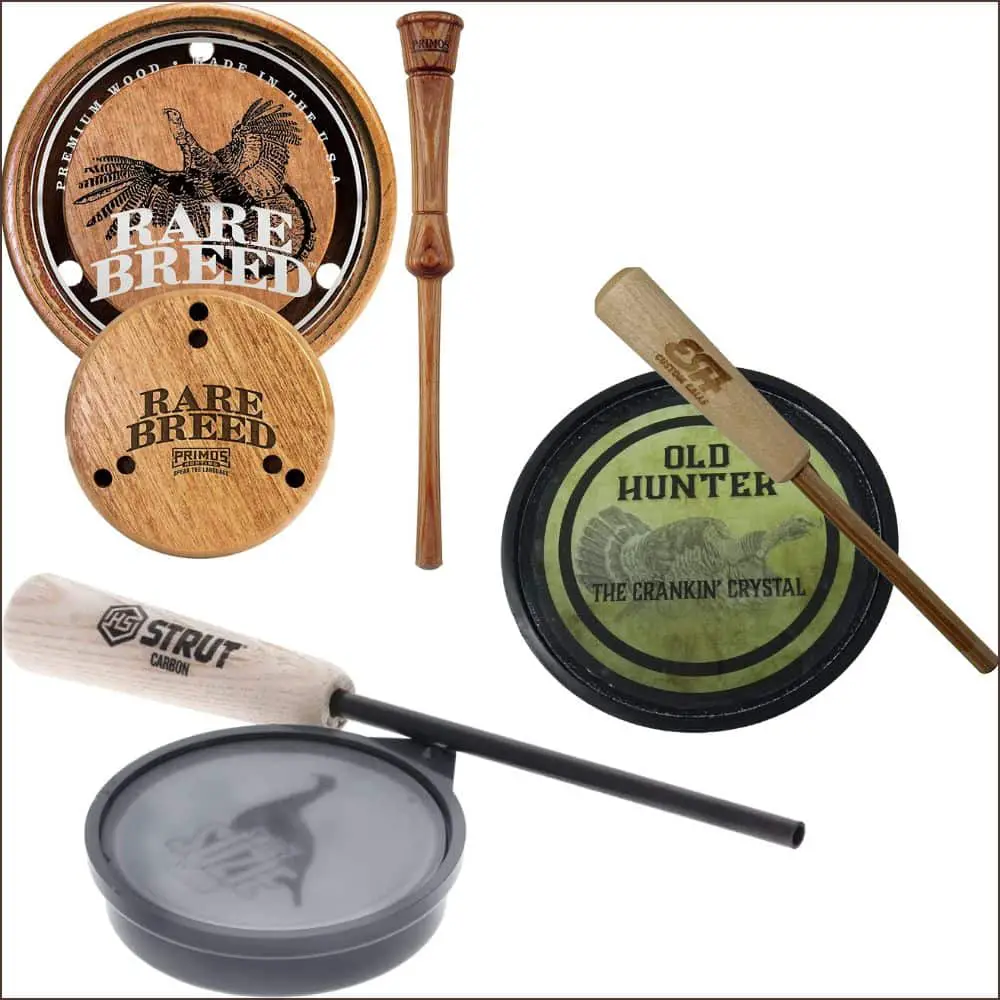
Pot calls are popular among turkey hunters for producing soft, subtle turkey sounds, as they can achieve these nuances by simply rubbing their smooth surface with a striker.
This smooth surface is usually crafted from slate, glass, crystal, aluminum, or ceramic – each emitting its distinct sound. Despite this variety of materials to choose from when manufacturing these friction calls, the two most common types hunters choose are slate and glass.
Diaphragm Calls

Diaphragm calls, also known as mouth calls, are placed inside the hunter's mouth, and the sound is made by manipulating the pressure of the tongue, teeth, and lips. They are versatile and can create a wide range of turkey sounds.
A mouth call is the cheapest call you can buy, and it produces highly accurate sounds but has a steep learning curve.
Push Button Calls
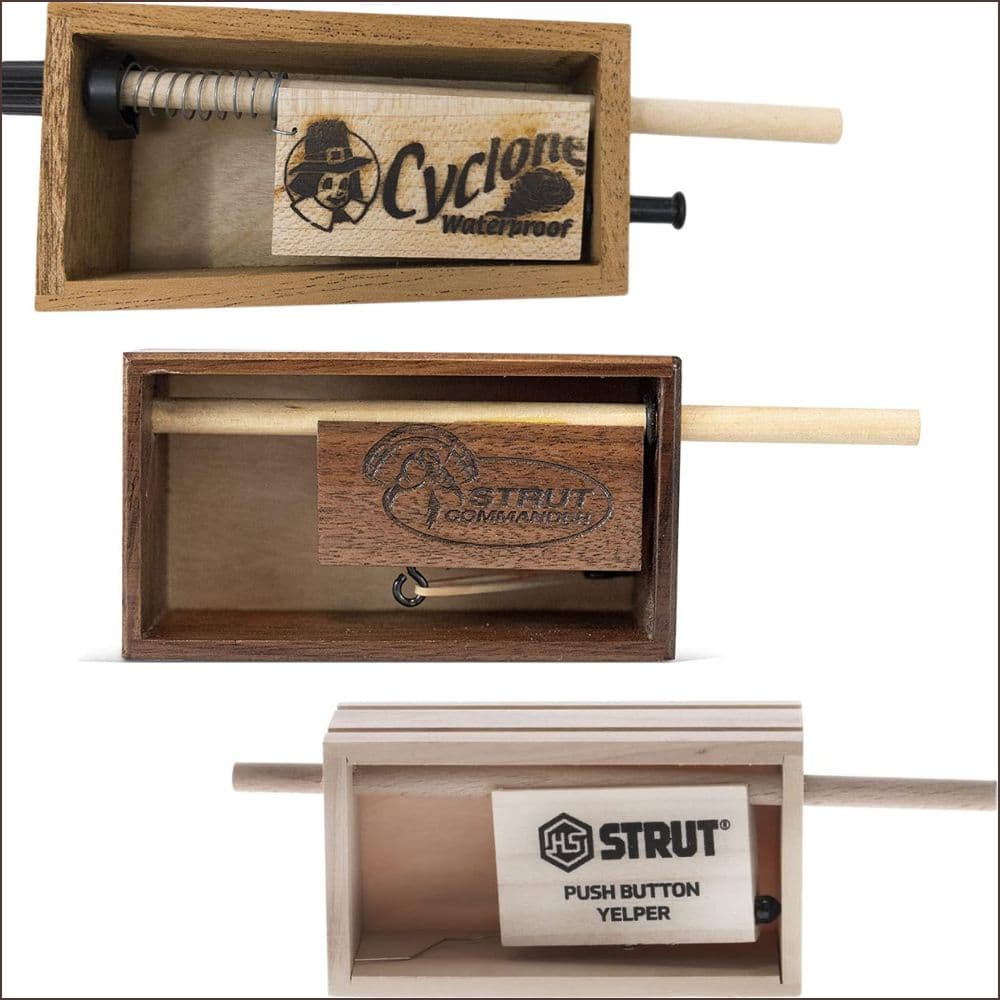
Push button calls are friction calls that are easy to use and operate with one hand. They consist of a small wooden rod-like structure ( like a button) that is pushed to create a sound. They are ideal for beginners and can produce a variety of turkey sounds.
Wing Bone Calls
Wing bone calls are one of the oldest types of turkey calls made from the bones of a turkey's wing. They are challenging but can produce realistic turkey sounds by blowing air through them.
Locator Calls
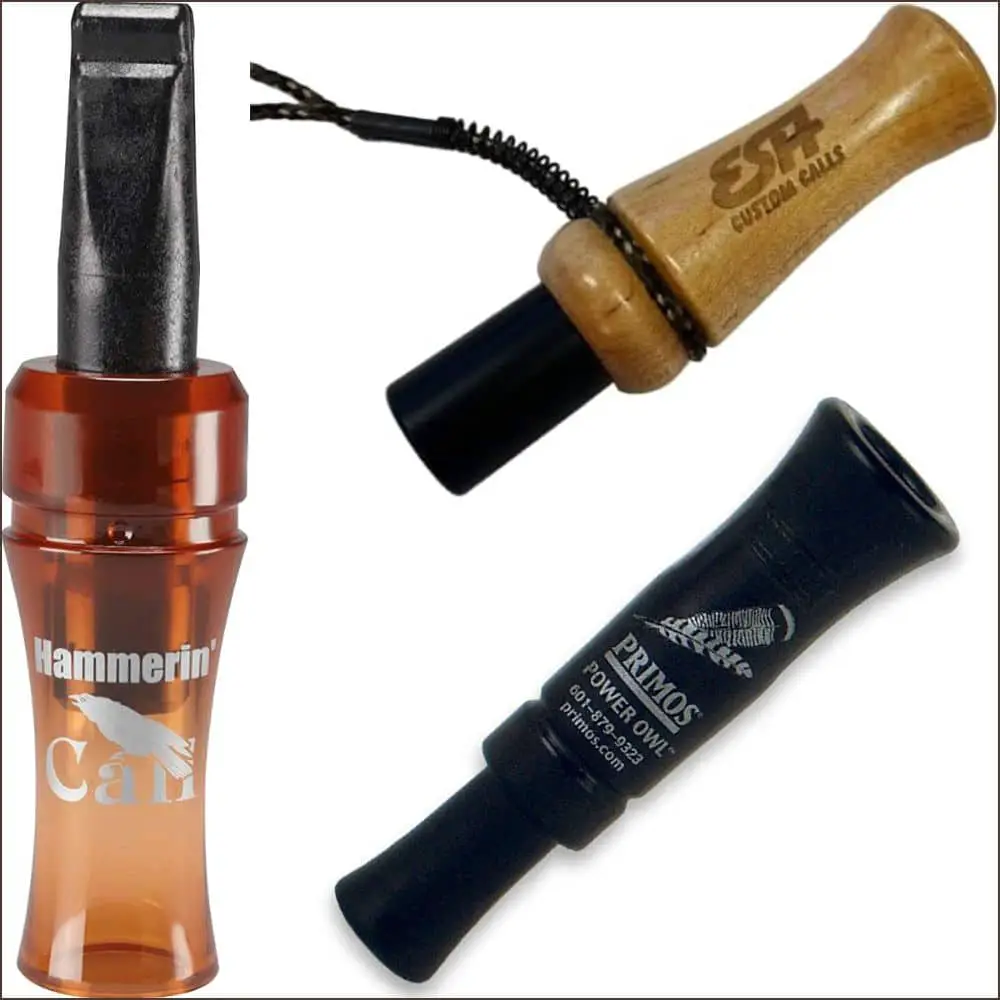
Locator calls are used to locate turkeys and are not intended to mimic turkey sounds. They mostly use hollow tubes that can mimic the sounds of different animals when air is blown into them.
The most common are crow calls, owl hoots, and other predator calls that will cause turkeys to respond and give away their position.
Electronic Calls
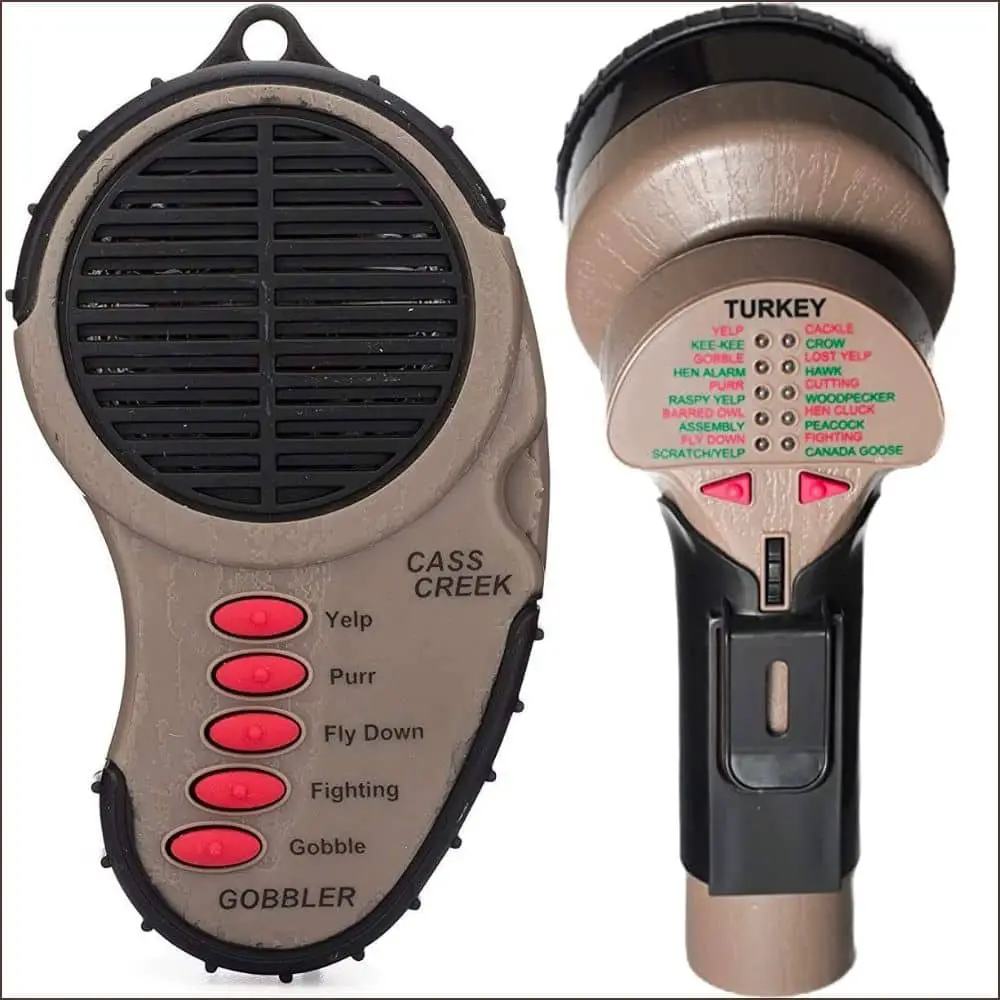
Electronic turkey calls are the newest type of call on the market, and they can be used to replicate various turkey sounds. They typically come with pre-programmed soundtracks that hunters can play to attract turkeys.
Electronic calls also provide more volume than conventional methods, making them useful for hunting in wide open spaces.
Check out our article on the Best Turkey Calls, to know more about the top turkey calling devices on the market.
Using Turkey Calls
Once you have chosen a turkey call, it is essential to learn how to use it effectively before you can actively start blind-calling live turkeys. Here are some tips for using turkey calls:
Basic Techniques
- Hold the call correctly: For box calls, hold the lid in your non-dominant hand, and use your dominant hand to move it back and forth. For diaphragm calls, place it on the roof of your mouth, and use your tongue to control the sound.
- Practice the sounds: Listen to real turkeys or instructional videos to learn how the different calls should sound, and practice replicating them, not other turkey hunters.
- Use different volumes: Experiment with different volumes to find what works best for the particular hunting situation.
- Be patient: Give turkeys time to respond and avoid over-calling or too aggressive calling, which can scare them away.
Advanced Techniques
- Mix up the calls: Use different calls in different sequences to create a more realistic and varied sound.
- Mimic turkey behavior: Try to replicate the sounds of a turkey as it moves and interacts with other turkeys in the area.
- Use different pitches: Varying the pitch of the calls can help attract turkeys of different ages and genders.
Diaphragm Calls require the maximum amount of practice. And to get you started, check out the whole 8-part video series from Primos Hunting:
Check out our article on turkey hunting tips that can increase your chances of a successful and memorable experience in the rain.
Turkey Calling Strategies
Different turkey calling strategies are effective in different hunting situations. Here are some common strategies to call turkey:
The Roost
Call the turkeys on the roost early in the morning before they fly down to feed. Mimic is the sound of a hen to attract the toms.
The Strut Zone
The strut zone is where male turkeys go to display their feathers and attract hens. Mimic is the sound of a female to attract the males.
The Feeding Area
Call turkeys in the feeding area to attract them to your location. Use soft, subtle calls to avoid spooking them.
The Travel Route
Turkeys will often travel along established routes between feeding and roosting areas. Use locator calls to find these routes and set them up in a good position to call the turkeys.
Turkey Calling Contest
Now that you've honed your turkey calling expertise, why not take on an invigorating new challenge? Joining a turkey-calling contest could be the perfect opportunity for you.
These contests allow hunters to demonstrate their skills by imitating turkey sounds using diverse calls and methods - all while competing against like-minded individuals and earning prizes!
But with so many talented hunters, how can you improve your chances of coming out on top? Here are some tips to help you up your game in the turkey-calling contest arena.
First and foremost, practice, practice, practice. Mastering the different types of turkey calls - such as box, slate, and diaphragm - takes time and effort. But the more you practice, the more natural and confident you will become, giving you an edge over the competition.
Another key to success is to pay close attention to the contest rules and judges' criteria. Make sure you understand the scoring system, as well as any restrictions on calls or techniques. This will help you tailor your performance to maximize your score.
Additionally, don't be afraid to get creative with your calling. While sticking to traditional turkey sounds is a safe bet, adding unique sounds or calls you've personally observed in the wild can make your performance stand out and impress the judges.
Lastly, don't let nerves get the best of you. Turkey calling contests can be intense, but remember to stay focused and confident. Take a deep breath, visualize your success, and let your skills do the talking.
Final Thoughts
Calling turkeys is critical to successfully hunting more turkeys, and hunters can use many different types of calls and techniques.
By understanding the different turkey vocalizations, choosing the right call, and using it effectively, hunters can increase their chances of success. Remember to practice your turkey calls and experiment with different techniques to find what works best for you.
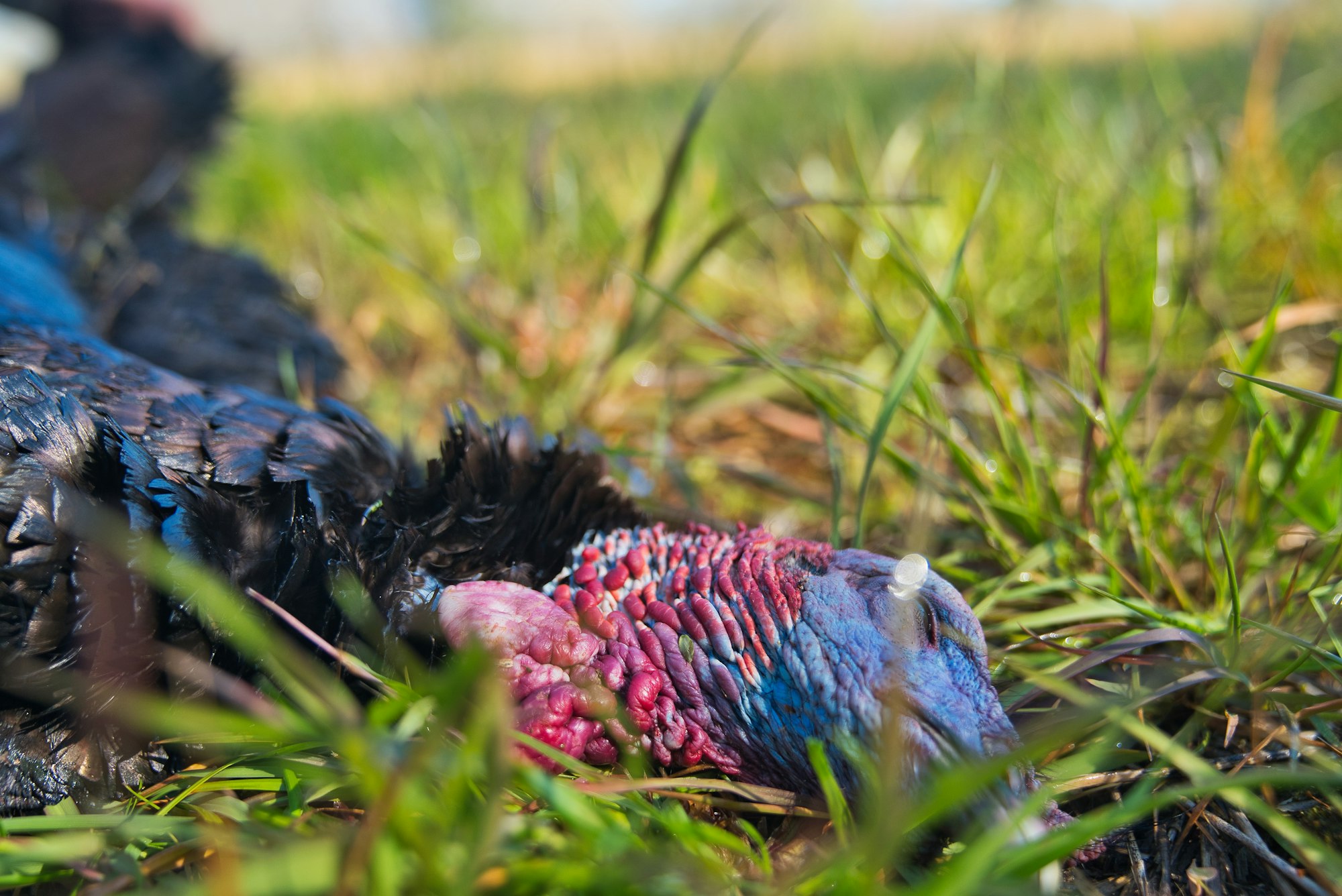
Also, check out some of our other articles:

